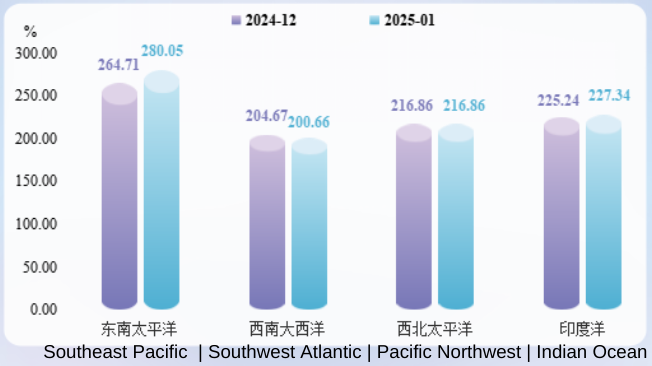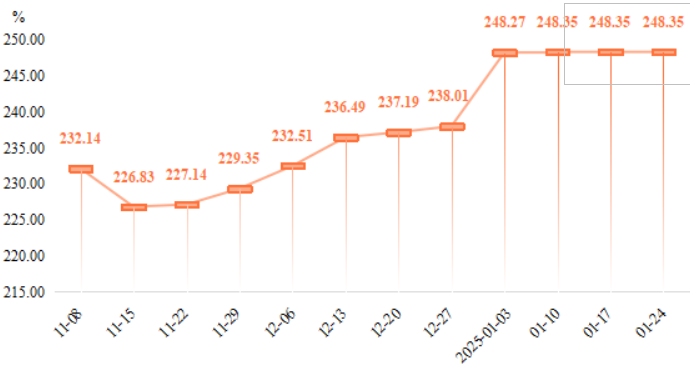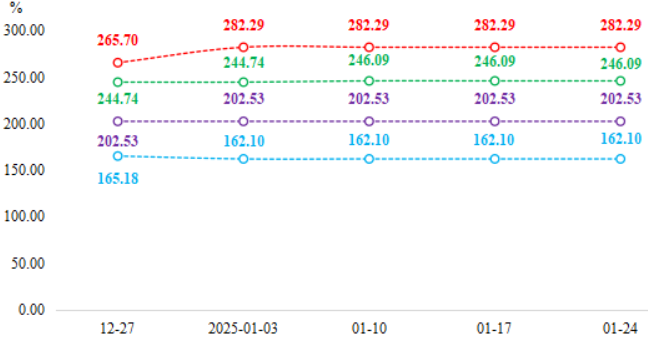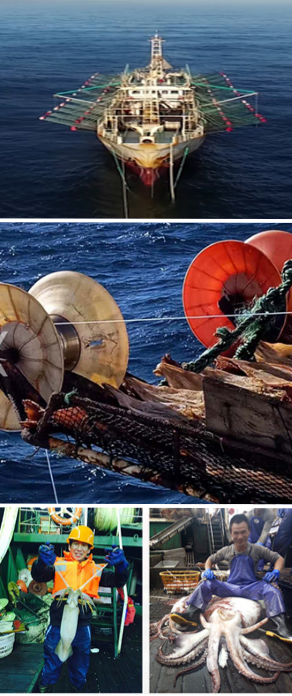|

Image: China Ocean Squid Index Network
Comments on China's Ocean-going Squid Price Index – January 2025
 CHINA
CHINA
Tuesday, February 18, 2025, 00:10 (GMT + 9)
China’s Ocean-going Squid Price Index is jointly compiled and published by Zhejiang Zhoushan International Agricultural Products Trading Center Co., Ltd. and Shuliang Technology.
The contents and analyses presented herein are for informational purposes only. Given the volatility of the squid market, the price index is intended solely to reflect domestic price trends.

In this edition, the China Ocean Squid Price Index for January 2025 has been calculated using price data from various sea areas, as provided by Zhejiang Zhoushan International Agricultural Products Trading Center Co., Ltd., and analyzed using the Shuliang Technology Index Model. This report aims to deliver authoritative and scientifically based insights into market trends for both producers and consumers, as per Shuliang Technology.
I. Overall Index Performance
According to data from Zhejiang Zhoushan International Agricultural Products Trading Center Co., Ltd., China’s monthly price index for distant-water squid continued its upward trend in January 2025, reaching a record high. The weekly price index remained stable at 248.35 points for three consecutive weeks, reflecting a marginal increase of 0.03% compared to the final week of 2024.
II. Monthly Squid Price Index Analysis
In January 2025, squid supply remained constrained, market inventories continued to decline, and China’s monthly ocean squid price index rose to a record high of 255.49 points, marking a 3.79% month-on-month increase and a 63.56% rise year-on-year.
(1).png)
Trend of China's Ocean Squid Price Index (monthly)
Among the four major squid fishing areas, price trends exhibited “two increases, one stable, and one decrease.”
-
Southeast Pacific Ocean: The squid price index experienced the highest fluctuation, closing at 280.05 points, a 5.80% month-on-month increase. Despite optimism about resource improvements in 2025, challenging fishing conditions and declining inventories contribute to continued uncertainty.
-
Southwest Atlantic Ocean: Early fishing results were promising. Reports indicate that approximately 70 vessels operated in the 44–45°S region, averaging 35 tons per night. Initial landings showed improved quality and volume compared to previous years. However, as market activity slowed during the Spring Festival, the price index dropped by 1.96% to 200.66 points.
-
Northwest Pacific Ocean & Indian Ocean: These regions contribute a smaller share of global squid production, with price movements influenced by external markets. The Northwest Pacific index remained stable at 216.86 points, while the Indian Ocean index increased slightly by 0.93% to 227.34 points.

Monthly price index trend of pelagic squid in various sea areas
III. Weekly Squid Price Index Trends
China’s offshore squid weekly price index exhibited stability throughout January 2025. The index saw a marginal rise of 0.08% in the first week, before maintaining a steady level at 248.35 points.
 # #
Trend of China’s Ocean-going Squid Price Index (weekly)
(Note: 2025.01.04-01.10 is the first week of January. Due to the Spring Festival holiday, the market was closed from 2024.01.25 to 01.31, so January only includes three weeks of data)
Weekly trends across the four major fishing areas were largely uniform. The indices for the Southeast Pacific, Southwest Atlantic, and Northwest Pacific remained unchanged throughout January. Only the Indian Ocean index recorded a slight 0.55% increase in the first week before stabilizing.
.png)

Weekly price index trend of pelagic squid in various sea areas
IV. Index Trend Forecast
Post-Spring Festival data suggests that the squid market remains in a stable supply-demand equilibrium. While prices remain high, trading activity is subdued.
Currently, distant-water fishing fleets primarily operate in equatorial and southwestern Atlantic waters. The average daily squid catch in the equatorial region is estimated at 5–8 tons, with smaller overall sizes. According to the Argentine National Secretariat of Agriculture, Livestock, and Fisheries, cumulative squid landings from January 1 to February 4, 2025, reached 27,616 tons. As additional squid enter the market, supply constraints should ease. However, given continued weak fishing conditions in the Southeast Pacific and a gradual rebound in post-holiday market demand, the squid price index is expected to remain elevated and volatile in the short term.
V. Price Index Projection
 DeepSeek (R1) forecasts the squid price index will reach 262.50 points in February 2025. DeepSeek (R1) forecasts the squid price index will reach 262.50 points in February 2025.
1. Forecasting model: moving average + trend extrapolation
2. Key assumptions:
. The fishing situation in the Southeast Pacific has not improved significantly, and there is still pressure on the supply side;
. The pace of new goods arriving at the port is stable, and there is no concentrated increase in volume to impact the market;
. The recovery speed of market demand after the new year is in line with expectations.
3. Risk Warning:
. Upside risks: If fishing conditions deteriorate or demand exceeds expectations, the index could break through 265.00 points;
. Downside risk: If the arrival of new goods exceeds the limit or terminal consumption is weak, the index may fall back below 260.00 points.
Note: The prediction information is provided by DeepSeek (R1). The publisher is not responsible for its reliability and it is for reference only.
editorial@seafood.media
www.seafood.media
|



